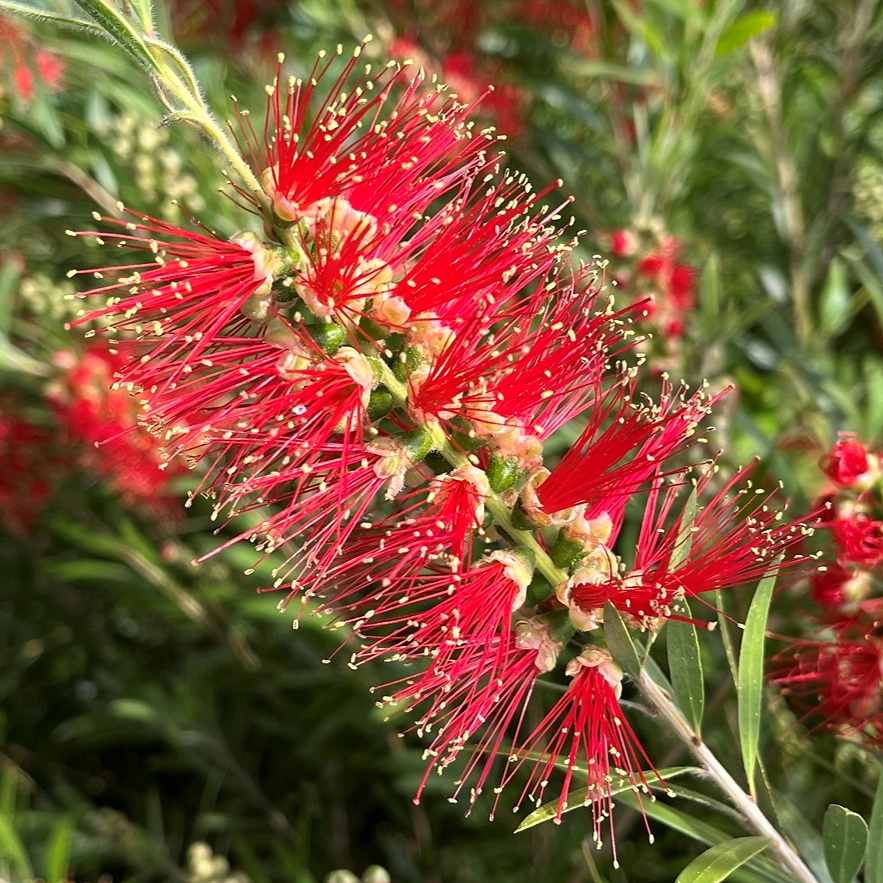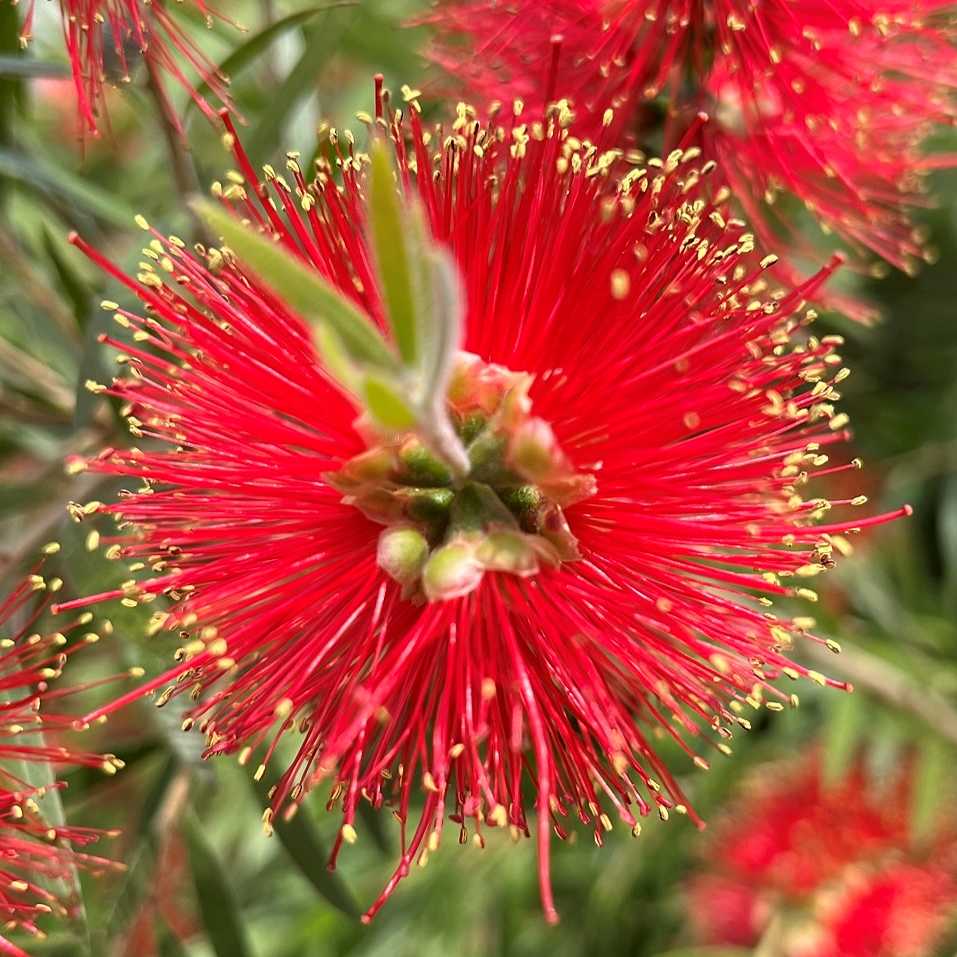ブラシノキの名前の由来は花の形が瓶を洗うブラシに似ているから。花が美しく、しかも珍しく、庭木のほか、切り花や枝物で観賞されます。
The name of Bottlebrush comes from the fact that the shape of the flower resembles a brush that washes a bottle. The flowers are beautiful and rare, and you can enjoy them as garden trees, cut flowers and branches.
【仮名】ブラシノキ, カリステモン, ハナマキ, キンポウジュ
【和名】ブラシの木, 花槇, 金宝樹
【英名】Bottlebrush
【学名】Callistemon speciosus
【誕生】05/ 19
【開花】05, 06月
【花色】White, Pink, Red, Purple



ブラシノキ
ブラシノキの来歴
ブラシノキはフトモモ科の常緑樹です。原産地はオーストラリア。日本へは明治時代の中頃に移入されました。「金宝樹」という別名の通り、花が美しく、しかも珍しく、庭木のほか、切り花や枝物で観賞。ただし寒さが苦手なので日当たりがよく、風の当たらないところを好みます。
ブラシノキの名前
ブラシノキの名前の由来は花の形が瓶を洗うブラシに似ているから。英名も「ボトルブラシ」です。ブラシのように見えるのは雄しべが筒状に密生するから。ラテン語の属名カリステモンも「美しい雄しべ」という意味です。別名「花槇」は葉が「羅漢槇」や「犬槇」に似ているから。
ブラシノキの花
ブラシノキの花穂は、伸びた枝の先に着き、枝垂れるように咲きます。花は派手な赤色の雄しべが多数、地味な緑色の花被片が5枚。花が終わると、小さなお椀型の果実を結びます。さながら枝に巻き付くタコの吸盤のよう。翌年、その先に枝が伸び、新たな花穂が着いて枝垂れます。
ブラシノキの種子
ブラシノキの果実は木質化して何年も枝に留まります。果実の中は微小な種子がびっしり。果実は極度の旱魃や山林火災で弾け、種子を風に乗せて散らします。まだ他の植物が少ないうちに、すばやく芽を出し、そのあたり一帯を優占。旱魃や火災が多い環境に適応した繁殖戦略です。
ブラシノキの種類
ブラシノキ属34種のうち、おもな観賞用は次の4種です。5月に開花する「スペキオスス」は耐寒性で庭植え向き。一方、春から秋まで開花するのは、桃色から紫色まで花色が豊富な「キトリヌス」、花穂が緑色を帯びた白色の「サリグヌス」、枝先が下垂する「ウィミナリス」です。
Bottlebrush
History of Bottlebrush
Bottlebrush is an evergreen tree of the family Myrtaceae. The place of origin is Australia. It was introduced to Japan in the middle of the Meiji era. As the other name “Kimpoju”, the flowers are beautiful and rare, and you can enjoy them as garden trees, cut flowers and branches. However, they are not good at cold, so they prefer a place that is sunny and out of the wind.
Bottlebrush name
The name of Bottlebrush comes from the fact that the shape of the flower resembles a brush that washes a bottle. The English name is also “bottle brush”. It looks like a brush because the stamens are densely formed in a tubular shape. The Latin genus Callistemon also means “beautiful sword”. Another name “Hanamaki” is because the leaves are similar to “Rakanmaki” and “Inumaki”.
Bottlebrush flower
The flower ears of the Bottlebrush reach the tip of the elongated branch and bloom like weeping. The flowers have many flashy red stalks and five plain green flower pieces. When the flowers are finished, they make small bowl-shaped fruits. Just like an octopus sucker that wraps around a branch. The following year, a branch grows ahead of it, and a new flower spike arrives and weeps.
Bottlebrush seeds
The fruits of the Bottlebrush become woody and stay on the branches for many years. The fruits are full of tiny seeds. The fruits pop in extreme droughts and forest fires, and the seeds are scattered in the wind. While there are still few other plants, they sprout quickly and occupy the area. It is a breeding strategy adapted to the environment where there are many droughts and fires.
Types of Bottlebrush
Of the 34 species of the genus Brush, the following 4 are the main ornamental species. “Speciosus”, which blooms in May, is cold-resistant and suitable for garden planting. On the other hand, the flowers that bloom from spring to autumn are “Citrinus”, which has abundant flower colors from pink to purple, “Salignus”, which has greenish ears, and “Viminalis”, which has hanging branches.


